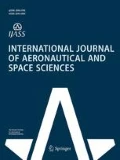Abstract
This paper proposes a practical optimal guidance law that can handle terminal angle and acceleration constraints while providing robustness against uncertainty in autopilot dynamics. Building upon a well-established linear-quadratic optimal guidance framework, we first derive an energy-minimizing guidance scheme that nullifies terminal acceleration called optimal guidance law with impact angle and terminal acceleration constraints (OGL–IATA). Then, a practical modification to OGL–IATA is proposed to deal with the stability degradation of OGL–IATA due to unmodeled high-order autopilot dynamics. The modification primarily features feedback of pseudo-acceleration that is computed by passing the true acceleration signal through approximate missile dynamics; this simple modification is demonstrated to improve the stability margin of the guidance loop. Numerical examples of nonlinear engagement kinematics demonstrate the performance and the robustness characteristics of the proposed practical guidance scheme.











Similar content being viewed by others
Change history
18 October 2021
A Correction to this paper has been published: https://doi.org/10.1007/s42405-021-00418-3
References
Murtaugh SA, Criel HE (1966) Fundamentals of proportional navigation. IEEE Spectr 3(12):75–85
Benecke T, Quick AW (1956) History of German guided missile development. In: Proceedings of AGARD first guided missile seminar, 1956
Nesline FW, Zarchan P (1981) A new look at classical versus modern homing guidance. J Guid Control Dyn 4:78–85
Fossier MW (1984) The development of radar homing missiles. J Guid Control Dyn 7:641–651
Yuan CL (1948) Homing and navigation courses of automatic target-seeking devices. J Appl Phys 19:1122–1128
Ochi Y, Kominami T (2005) Flight control for automatic aerial refueling via PNG and LOS angle control. In: AIAA guidance, navigation, and control conference and exhibit, p 6268, 2005
Yamasaki T et al (2007) Robust trajectory-tracking method for UAV guidance using proportional navigation. In: 2007 international conference on control, automation and systems, pp 1404–1409, 2007
Han D, Wang XI, Zhao M, Duan DP (2017) An improved proportional navigation guidance law for waypoint navigation of airships. In: Information technology and intelligent transportation systems. pp 373–383
He S, Lee CH, Shin HS, Tsourdos A (2019) Minimum-effort waypoint-following guidance. J Guid Control Dyn 42(7):1551–1561
Zarchan P (2012) Tactical and strategic missile guidance, 6th edn. American Institute of Aeronautics and Astronautics, Washington DC
Bryson A, Ho YC (1975) Applied optimal control. Wiley, New York
Lin CF (1991) Modern navigation, guidance, and control processing. Prentice Hall, Upper Saddle River
Shaferman V, Shima T (2008) Linear quadratic guidance laws for imposing a terminal intercept angle. J Guid Control Dyn 31(5):1400–1412
Ryoo CK, Cho H, Tahk MJ (2005) Optimal guidance laws with terminal impact angle constraint. J Guid Control Dyn 28(4):724–732
J.I. lee, J.I. Soo, C.H. Lee, (2014) Command-shaping guidance law based on gaussian weighting function. IEEE Trans Aerosp Electron Syst 50(1):772–777
Moon J, Kim Y (2001) Design of missile guidance law via variable structure control. J Guid Control Dyn 24(6):659–664
Shima T, Idan M, Golan OM (2006) Sliding-mode control for integrated missile autopilot guidance. J Guid Control Dyn 29(2):250–260
Bezick S, Rusnak I, Gray WS (1995) Guidance of a homing missile via nonlinear geometric control method. J Guid Control Dyn 18(3):441–448
Lee CH, Shin HS, Lee JI, Tahk MJ (2017) Zero-effort-miss shaping guidance laws. IEEE Trans Aerosp Electron Syst 54(2):693–705
Yang CD, Chen HY (1998) Nonlinear H-infinity robust guidance law for homing missiles. J Guid Control Dyn 21(6):882–890
Talole SE, Banavar RN (1998) Proportional navigation through predictive control. J Guid Control Dyn 21(6):1004–1006
Tekin R, Erer KS, Holzapfel F (2017) Polynomial shaping of the look angle for impact-time control. J Guid Control Dyn 40(10):2668–2673
Lee CH, Kim TH, Tahk MJ, Whang IH (2013) Polynomial guidance laws considering terminal impact angle and acceleration constraints. IEEE Trans Aerosp Electron Syst 49(1):74–92
Moon HB, Jung YK, Ra WS (2015) Terminal acceleration stabilizing guidance law for impact angle constrained interception of a non-maneuvering target. Int J Control Autom Syst 13(6):1410–1422
Ryoo CK, Cho H, Tahk MJ (2006) Time-to-go weighted optimal guidance with impact angle constraints. IEEE Trans Control System Technol 14(3):483–492
Ohlmeyer EJ, Phillips CA (2006) Generalized vector explicit guidance. J Guid Control Dyn 29(2):261–268
Lee CH, Lee JI, Tahk MJ (2015) Sinusoidal function weighted optimal guidance laws. Proc Inst Mech Eng Part G J Aerosp Eng 229(3):534–542
Ryu MY, Lee CH, Tahk MJ (2015) Command shaping optimal guidance laws against high-speed incoming targets. J Guid Control Dyn 38(10):2025–2033
Lee YI, Ryoo CK, Kim E (2003) Optimal guidance with constraints on impact angle and terminal acceleration. In: AIAA guidance and control conference and exhibit, AIAA paper 2003-5795, 2003
Nesline FW, Wells BH, Zarchan P (1981) A combined optimal/classical approach to robust missile autopilot design. AIAA Guid Control 4(3):316–322
Lee CH, Jun BE, Lee JI (2016) Connection between linear and nonlinear missile autopilots via three-loop topology. J Guid Control Dyn 39(6):1424–1430
Skogestad S, Postlethwaite I (2007) Multivariable feedback control: analysis and design. Wiley, New York
Author information
Authors and Affiliations
Corresponding author
Additional information
Publisher's Note
Springer Nature remains neutral with regard to jurisdictional claims in published maps and institutional affiliations.
The original online version of this article was revised: Due to an unfortunate mistake during the correction process, figure 7 overlaps the text.
Rights and permissions
About this article
Cite this article
Chi, HS., Lee, YI., Lee, CH. et al. A Practical Optimal Guidance Scheme Under Impact Angle and Terminal Acceleration Constraints. Int. J. Aeronaut. Space Sci. 22, 923–935 (2021). https://doi.org/10.1007/s42405-020-00339-7
Received:
Revised:
Accepted:
Published:
Issue Date:
DOI: https://doi.org/10.1007/s42405-020-00339-7




